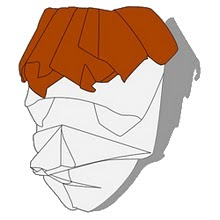Sunday, January 31, 2010
It's almost a new year
The Chinese new year is coming up on February 14th, and everyone if folding tigers. It seems to me that the Chinese zodiac challenge is the biggest unofficial challenge every year. This year is a bit different because tigers aren't exactly easy to fold, especially if you like color changes like I do. I doodled for a long time with just the stripes and found out that there are three (or maybe more) ways to make stripes. You can use offset reverse folds, spread pleats or use an offset grid. I tried to make tigers with all of these methods, and ended up liking the offset grid the most, even though my tiger didn't end up with legs. Thats why I decided to call it Tiger Pelt.
 The diagonal lines that make the grid offset starts from the top 1/4 of the square and goes to the bottom 1/8 in the corners. As you can see, it is based on an 8:8 grid. With the head (on the bottom of the CP), you can make all sorts of different things because there are plenty of flaps. I kept it simple and just added a nose, eyes and ears. You can thin the tail and the very top middle part of the model can make another stripe.
The diagonal lines that make the grid offset starts from the top 1/4 of the square and goes to the bottom 1/8 in the corners. As you can see, it is based on an 8:8 grid. With the head (on the bottom of the CP), you can make all sorts of different things because there are plenty of flaps. I kept it simple and just added a nose, eyes and ears. You can thin the tail and the very top middle part of the model can make another stripe.


Monday, January 25, 2010
A Few More Sides
Ever since seeing Andrew's Pentagon Pig, I had to try making a model from a pentagon. I ended up getting a bit distracted and decided that folding an insect from a heptagon would be a better idea. It took me a while to find instructions on how to fold a regular heptagon from a square (in fact, the ones that I found weren't really good... they could do with some simplification), and then I started folding. At first, I had something that looked like a turtle with six legs, using only the corners of the heptagon for flaps. I gave up one that idea pretty quickly, and started doodling. A couple of folds into the doodle, I knew that I would end up with a dolphin. How do you get a dolphin from a heptagon? I'll show you how.

Thats how. There are quite a few details to be added after that. With a crimp near the top, you can form the head section. Then you can make the head with some reverse folds and a petal fold. Another reverse fold makes a flipper, and the excess of the body can be folded beneath. The flipper actually took me seven tries to get it right, which ended up being on the final model. The tail just needs to be folded downwards and thinned with two layers tucked inside and a closed sink. A couple of folds underneath can make a nice lock in the middle of the tail. Here are some pictures of my final dolphin.


Thats how. There are quite a few details to be added after that. With a crimp near the top, you can form the head section. Then you can make the head with some reverse folds and a petal fold. Another reverse fold makes a flipper, and the excess of the body can be folded beneath. The flipper actually took me seven tries to get it right, which ended up being on the final model. The tail just needs to be folded downwards and thinned with two layers tucked inside and a closed sink. A couple of folds underneath can make a nice lock in the middle of the tail. Here are some pictures of my final dolphin.
Subscribe to:
Comments (Atom)

